.gif)
Disused railway stations (Exeter to Plymouth Line)
Encyclopedia
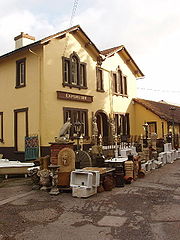
Exeter St Davids railway station
Exeter St Davids station is the most important of seven National Rail stations in the city of Exeter in southwest England. Today the station is owned by Network Rail and operated by First Great Western.-History:...
and Plymouth Millbay
Plymouth Millbay railway station
Plymouth Millbay railway station was the original railway terminus in Plymouth, Devon, England. It was used for passenger trains from 1849 to 1941.- History :...
, Devon
Devon
Devon is a large county in southwestern England. The county is sometimes referred to as Devonshire, although the term is rarely used inside the county itself as the county has never been officially "shired", it often indicates a traditional or historical context.The county shares borders with...
, England
England
England is a country that is part of the United Kingdom. It shares land borders with Scotland to the north and Wales to the west; the Irish Sea is to the north west, the Celtic Sea to the south west, with the North Sea to the east and the English Channel to the south separating it from continental...
. At eight of these there are visible remains.
Background
The South Devon RailwaySouth Devon Railway Company
The South Devon Railway Company built and operated the railway from Exeter to Plymouth and Torquay in Devon, England. It was a broad gauge railway built by Isambard Kingdom Brunel-Chronology:* 1844 South Devon Railway Act passed by parliament...
was opened in stages between 30 May 1846 and 2 April 1849. It was originally designed to operate on the atmospheric principle
Atmospheric railway
An atmospheric railway uses air pressure to provide power for propulsion. In one plan a pneumatic tube is laid between the rails, with a piston running in it suspended from the train through a sealable slot in the top of the tube. Alternatively, the whole tunnel may be the pneumatic tube with the...
but this was not successful and was never completed beyond Newton Abbot
Newton Abbot railway station
Newton Abbot railway station serves the town of Newton Abbot in Devon, England. It is from London on the Exeter to Plymouth line via the Reading to Taunton line, at the junction for the branch to . For many years it was also the junction for Moretonhampstead and the site of a large locomotive...
. It was amalgamated
Consolidation (business)
Consolidation or amalgamation is the act of merging many things into one. In business, it often refers to the mergers and acquisitions of many smaller companies into much larger ones. In the context of financial accounting, consolidation refers to the aggregation of financial statements of a group...
into the Great Western Railway
Great Western Railway
The Great Western Railway was a British railway company that linked London with the south-west and west of England and most of Wales. It was founded in 1833, received its enabling Act of Parliament in 1835 and ran its first trains in 1838...
on 1 February 1876 and now forms part of the Exeter to Plymouth Line
Exeter to Plymouth Line
The Exeter to Plymouth line is a central part of the trunk railway line between London Paddington and Penzance railway stations in the southern United Kingdom. It is a major branch of the Great Western Main Line and runs from Exeter, to Plymouth, from where it continues as the Cornish Main Line...
.
Exminster
Located at 50.67498°N 3.48236°W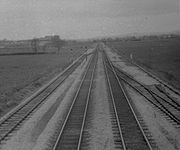
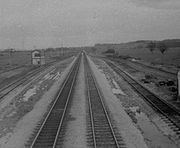
Exminster
Exminster is a village situated on the southern edge of the City of Exeter on the western side of the Exeter ship canal and River Exe in the county of Devon, England. It is around south of the centre of Exeter, and has a population of 3,084 . Exminster is an ancient village associated with a Saxon...
by George Hennet
George Hennet
George Hennet was a railway engineer and contractor. He undertook many contracts for Isambard Kingdom Brunel's broad gauge railways in the South West of England and funded the provision of extra facilities on the South Devon Railway, these formed the basis of a general trading business that he...
. It was opened in August 1852 and operated by him on behalf of the South Devon Railway until January 1857 when the railway company took over. An Italianate building on the west side of the single track housed a booking office and waiting room on the ground floor, with accommodation above for the station master. Hennet also operated a goods siding and coal shed at the station.
It was situated where a bridge carried a road down to a ferry across the River Exe
River Exe
The River Exe in England rises near the village of Simonsbath, on Exmoor in Somerset, near the Bristol Channel coast, but flows more or less directly due south, so that most of its length lies in Devon. It reaches the sea at a substantial ria, the Exe Estuary, on the south coast of Devon...
to Topsham
Topsham, Devon
Topsham is a suburb of Exeter in the county of Devon, England, on the east side of the River Exe, immediately north of its confluence with the River Clyst and the former's estuary, between Exeter and Exmouth. Although village-sized, with a current population of around 5,023, it was designated a...
. It had been proposed that a branch line should be built from Exminster across the river to Exmouth
Exmouth
Exmouth is a town in Devon. It may also refer to:Places*Exmouth Peninsula in Southern Chile*Exmouth, Western AustraliaPeople*Edward Pellew, 1st Viscount Exmouth , a British naval officerShips...
, but in the event the London and South Western Railway
London and South Western Railway
The London and South Western Railway was a railway company in England from 1838 to 1922. Its network extended from London to Plymouth via Salisbury and Exeter, with branches to Ilfracombe and Padstow and via Southampton to Bournemouth and Weymouth. It also had many routes connecting towns in...
built one instead from Exeter
Exeter
Exeter is a historic city in Devon, England. It lies within the ceremonial county of Devon, of which it is the county town as well as the home of Devon County Council. Currently the administrative area has the status of a non-metropolitan district, and is therefore under the administration of the...
.
The line through Exminster was doubled in November 1859 and so a second platform for southbound (down) trains was built; passengers used the road bridge to cross to it. The siding was extended to provide a refuge for up trains in 1894, and a down refuge siding was constructed north of the bridge in 1906; these allowed slow goods trains to be overtaken.
In 1924 the facilities were greatly enlarged. A new passenger loop was laid behind the southbound platform, so now down stopping passenger trains could be overtaken while in the station. This meant that the road bridge had to be extended across the loop line with a second span. A new signal box
Signal box
On a rail transport system, signalling control is the process by which control is exercised over train movements by way of railway signals and block systems to ensure that trains operate safely, over the correct route and to the proper timetable...
was provided at this time. In 1931 an up platform loop was squeezed into the space between the station building and the platform and the bridge extended again. A new booking office was provided on the approach to the bridge.
In 1940 the down refuge siding was converted into a loop so that goods trains could run straight in without reversing, and three loop sidings were provided behind the platform. These were originally intended to help the flow of goods traffic during the Second World War, but later became a useful place to stable empty passenger trains on busy summer Saturdays.
The station closed for passenger traffic on 30 March 1964 and for goods on 4 December 1967, although only coal traffic had been handled for the previous 27 months. The refuge sidings had already been removed by then, and the loop sidings behind the down platform converted to dead-ends. They continued to see occasional use until 1985. The signal box was closed on 14 November 1986 but remained in situ until September 2006 but has now been removed for preservation to Broadway, Worcestershire
Broadway, Worcestershire
Broadway is a village and civil parish in the Worcestershire part of the Cotswolds in England.Often referred to as the "Jewel of the Cotswolds", Broadway village lies beneath Fish Hill on the western Cotswold escarpment...
. The 1852 station building still survives.
Brent
Located at 50.42809°N 3.83475°WBrent railway station served the village of South Brent
South Brent
South Brent is a large village on the southern edge of Dartmoor, England, in the valley of the River Avon, population 2998 , 8 km north-east of Ivybridge, and next to the Devon Expressway which connects Exeter to the north-east and Plymouth to the west.-History:It was originally a woollen...
on the southern edge of Dartmoor
Dartmoor
Dartmoor is an area of moorland in south Devon, England. Protected by National Park status, it covers .The granite upland dates from the Carboniferous period of geological history. The moorland is capped with many exposed granite hilltops known as tors, providing habitats for Dartmoor wildlife. The...
. It was not ready when the railway was opened, but was brought into use six weeks later on 15 June 1848.
On 19 December 1893 the station became a junction, with the opening of the Kingsbridge Branch Line
Kingsbridge branch line
Kingsbridge branch line was a single track branch line railway in Devon, England. The line, which became known as the Primrose Line, opened in 1893 and despite local opposition closed in 1963. It left the Exeter to Plymouth line at Brent and ran , following the route of the River Avon to...
. The branch line closed on 16 September 1963 and there was little reason for the station after that. Goods traffic was withdrawn on 6 April 1964 and to passengers on 5 October 1964. The signal box
Signal box
On a rail transport system, signalling control is the process by which control is exercised over train movements by way of railway signals and block systems to ensure that trains operate safely, over the correct route and to the proper timetable...
was retained until 17 December 1973 when control of the line was transferred to the power signal box at .
The former signalbox and goods shed on the westbound (Plymouth) side are still intact.
Wrangaton
The station was opened with the line on 5 May 1848; at the time, the only intermediate station between TotnesTotnes railway station
Totnes railway station serves the towns of Totnes and Dartington in Devon, England. It is situated on the Exeter to Plymouth line and is operated by First Great Western...
and the temporary terminus at Laira. From 1849 to 1893 the station was known as Kingsbridge Road, becoming "Wrangaton" once more when the branch line to Kingsbridge
Kingsbridge
Kingsbridge is a market town and popular tourist hub in the South Hams district of Devon, England, with a population of about 5,800. It is situated at the northern end of the Kingsbridge Estuary, which is a textbook example of a ria and extends to the sea six miles south of the town.-History:The...
opened.
The station was closed to passengers on 2 March 1959 but goods traffic continued to be handled until 9 September 1963. Part of the platform is still visible just west of Wrangaton Tunnel, as are the former Admiralty sidings on the north side of the line.
Bittaford Platform
An unstaffed station was opened by the Great Western RailwayGreat Western Railway
The Great Western Railway was a British railway company that linked London with the south-west and west of England and most of Wales. It was founded in 1833, received its enabling Act of Parliament in 1835 and ran its first trains in 1838...
at Bittaford on 18 November 1907 and closed on 2 March 1959. It was situated immediately east of Bittaford Viaduct.
There were no goods facilities but Redlake Siding was opened ¾ mile to the west on 10 September 1911. This siding served a large china clay
Kaolinite
Kaolinite is a clay mineral, part of the group of industrial minerals, with the chemical composition Al2Si2O54. It is a layered silicate mineral, with one tetrahedral sheet linked through oxygen atoms to one octahedral sheet of alumina octahedra...
drier which processed clay brought by pipeline from Redlake on Dartmoor
Dartmoor
Dartmoor is an area of moorland in south Devon, England. Protected by National Park status, it covers .The granite upland dates from the Carboniferous period of geological history. The moorland is capped with many exposed granite hilltops known as tors, providing habitats for Dartmoor wildlife. The...
; the eight mile long, gauge Redlake Tramway
Redlake Tramway
The Redlake Tramway was a railway built to carry supplies and workers between Bittaford and the clay workings at Redlake, near the centre of the southern part of Dartmoor, Devon, England. It was built in 1911 to a gauge of , and ran for a circuitous ....
was used to carry materials between Redlake Siding and the clay pits.
There are no visible remains of the platform, but original iron tube fencing remains to be seen behind the site of the former London bound platform .The clay drier at Redlake Siding is still intact, now modified for use by an engineering company, despite the siding closing on 7 July 1932.
Ivybridge
Located at 50.39470°N 3.92440°WThe station at Ivybridge
Ivybridge
Ivybridge is a small town and civil parish in the South Hams, in Devon, England. It lies about east of Plymouth. It is at the southern extremity of Dartmoor, a National Park of England and Wales and lies along the A38 "Devon Expressway" road...
was not complete when the railway was opened, but was brought into use six weeks later on 15 June 1848. The building was situated on the north side of the track, immediately to the west of Ivybridge Viaduct.
The line originally had just a single track but was doubled to the west on 11 June 1893 and from the far side of the viaduct to the east on 13 August 1893. A new stone viaduct to replace Isambard Kingdom Brunel
Isambard Kingdom Brunel
Isambard Kingdom Brunel, FRS , was a British civil engineer who built bridges and dockyards including the construction of the first major British railway, the Great Western Railway; a series of steamships, including the first propeller-driven transatlantic steamship; and numerous important bridges...
's timber structure was brought into use in 1894 and allow the joining up of the double-track sections. This was on a new alignment which forced the construction of a new westbound (down) platform further back from the old line. The up platform was widened and this left the building set back at an odd angle to the track.
The goods shed at the station was replaced on 1 October 1911 by a new facility further west, which still survives in commercial use despite the public goods service being withdrawn on 2 November 1965. In 1968 this was altered for shipping china clay
Kaolinite
Kaolinite is a clay mineral, part of the group of industrial minerals, with the chemical composition Al2Si2O54. It is a layered silicate mineral, with one tetrahedral sheet linked through oxygen atoms to one octahedral sheet of alumina octahedra...
brought from workings on Dartmoor
Dartmoor
Dartmoor is an area of moorland in south Devon, England. Protected by National Park status, it covers .The granite upland dates from the Carboniferous period of geological history. The moorland is capped with many exposed granite hilltops known as tors, providing habitats for Dartmoor wildlife. The...
by lorry. A signal box was situated on the south side of the line between the station and the goods yard from 1895 until 1973. The station closed on 2 March 1965 but a replacement Ivybridge railway station
Ivybridge railway station
Ivybridge railway station is situated on the Exeter to Plymouth line and serves the town of Ivybridge in Devon, England. The station re-opened in 1994 to the east of the original station, which had been closed in 1965. The new station is located in the civil parish of Ugborough, and is operated by...
was opened a mile away on the far side of the viaduct on 15 July 1994. The goods shed is still standing.
Cornwood
A station was built at CornwoodCornwood
Cornwood is a village and civil parish in the South Hams in Devon, England. It has a population of 988.- Religion :The Church of St Michael's is Cornwood's parish church....
by George Hennet
George Hennet
George Hennet was a railway engineer and contractor. He undertook many contracts for Isambard Kingdom Brunel's broad gauge railways in the South West of England and funded the provision of extra facilities on the South Devon Railway, these formed the basis of a general trading business that he...
. It was opened in 1852 and operated by him on behalf of the South Devon Railway until January 1857 when the railway company took over. Until 1864 it was known as "Cornwood Road".
An Italianate building on the north side of the single track housed a booking office and waiting room on the ground floor, with accommodation above for the station master. It was situated in the ½ mile between Blatchford and Slade viaducts. The line was doubled from Hemerdon to Cornwood on 16 May 1893 and a signal box
Signal box
On a rail transport system, signalling control is the process by which control is exercised over train movements by way of railway signals and block systems to ensure that trains operate safely, over the correct route and to the proper timetable...
was opened at the east end of the station. The double line was extended to Blatchford viaduct on 19 November 1893. This doubling required the construction of a new platform for westbound (down) trains. A loop line was provided to the east of the platform for up trains which was closed on 26 February 1962; the signal box was kept in use until 26 February 1963.
The London bound platform and station building can still be seen from passing trains.
Plympton
Railway facilities in PlymptonPlympton
Plympton, or Plympton Maurice or Plympton St Maurice or Plympton St Mary or Plympton Erle, in south-western Devon, England is an ancient stannary town: an important trading centre in the past for locally mined tin, and a former seaport...
had originally been provided by the horse-drawn Plymouth and Dartmoor Railway
Plymouth and Dartmoor Railway
The Plymouth and Dartmoor Railway was a gauge horse-worked railway line in Devon, England. Most of the network had been replaced by conventional railways by 1888. The last surviving section, which continued to operate until 1960, is generally referred to as the Lee Moor Tramway...
, but their branch to Plympton was closed and sold to the South Devon Railway to allow the construction of their new line. The new station was not ready to be opened with the railway, but was brought into use six weeks later on 15 June 1848.
From 1 June 1904 it was the eastern terminus for enhanced Plymouth
Plymouth
Plymouth is a city and unitary authority area on the coast of Devon, England, about south-west of London. It is built between the mouths of the rivers Plym to the east and Tamar to the west, where they join Plymouth Sound...
area suburban services, which saw steam railmotor
GWR steam rail motors
The steam rail motors were self-propelled carriages operated by the Great Western Railway in England and Wales from 1903 to 1935. They incorporated a steam locomotive within the body of the carriage.-History:...
s used to fight competition from electric trams.
The station closed to passengers on 2 March 1959 but goods traffic continued to be handled until 1 June 1964.
Laira
A temporary terminus was opened at LairaLaira
Originally Laira was the name given to that part of the Plym estuary from the Cattewater up to Marsh Mills, Plymouth. It is also a name used to refer to the area of Plymouth situated around the Laira Traction Maintenance Depot. Much of the housing in the area was build around 1900 for employees of...
on the outskirts of Plymouth
Plymouth
Plymouth is a city and unitary authority area on the coast of Devon, England, about south-west of London. It is built between the mouths of the rivers Plym to the east and Tamar to the west, where they join Plymouth Sound...
on 5 May 1848 while work continued on Mutley Tunnel and the final stretch of the line to Millbay. Two wooden train shed
Train shed
A train shed is an adjacent building to a railway station where the tracks and platforms are covered by a roof. It is also known as an overall roof...
s were provided and a horse-drawn bus conveyed passengers to and from the town. It was closed when the line to Millbay was opened on 3 April 1849.
A new facility, known as "Laira Halt" (Located at 50.38272°N 4.10884°W) was opened by the Great Western Railway
Great Western Railway
The Great Western Railway was a British railway company that linked London with the south-west and west of England and most of Wales. It was founded in 1833, received its enabling Act of Parliament in 1835 and ran its first trains in 1838...
on 1 June 1904 close to the Laira engine shed
Laira TMD
Laira TMD is a railway Traction Maintenance Depot situated in Plymouth, Devon, England. The depot is operated by First Great Western and is mainly concerned with the overhaul and daily servicing of their fleet of High Speed Trains and also the DMUs used on local services...
. This, along with several other small stations, formed a scheme to introduce a suburban train service in competition with electric trams. Laira Halt was not particularly successful and was closed from 7 July 1930, although the steps leading to the platform can still be seen beside the tracks.
Lipson Vale Halt
Another of the small stations opened by the Great Western Railway on 1 June 1904 was "Lipson Vale Halt", situated between Laira Halt and the older station at Mutley, on the other side of Mutley Tunnel.The GWR suburban service was withdrawn on 7 July 1930, although local Southern Railway
Southern Railway (Great Britain)
The Southern Railway was a British railway company established in the 1923 Grouping. It linked London with the Channel ports, South West England, South coast resorts and Kent...
trains continued to call until 4 May 1942 when the station was closed and dismantled as its wooden platforms were thought to be a fire risk during The Blitz
The Blitz
The Blitz was the sustained strategic bombing of Britain by Nazi Germany between 7 September 1940 and 10 May 1941, during the Second World War. The city of London was bombed by the Luftwaffe for 76 consecutive nights and many towns and cities across the country followed...
.
Mutley
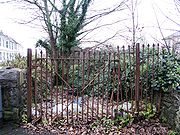
The second permanent station in Plymouth
Plymouth
Plymouth is a city and unitary authority area on the coast of Devon, England, about south-west of London. It is built between the mouths of the rivers Plym to the east and Tamar to the west, where they join Plymouth Sound...
was opened on 1 August 1871 to the west of the tunnel
Tunnel
A tunnel is an underground passageway, completely enclosed except for openings for egress, commonly at each end.A tunnel may be for foot or vehicular road traffic, for rail traffic, or for a canal. Some tunnels are aqueducts to supply water for consumption or for hydroelectric stations or are sewers...
beneath Mutley Plain
Mutley Plain
Mutley Plain is a street in Plymouth, Devon, England. Although Mutley Plain is the main street of the dense suburb called Mutley, the term is often applied to the whole area. The road is a busy dual-carriageway, the B3250, with eight sets of traffic lights/pelican crossings...
. It was financed by local people in return for a promise of railway shares once it was attracting a profitable level of business. It became a joint station used also by the London and South Western Railway
London and South Western Railway
The London and South Western Railway was a railway company in England from 1838 to 1922. Its network extended from London to Plymouth via Salisbury and Exeter, with branches to Ilfracombe and Padstow and via Southampton to Bournemouth and Weymouth. It also had many routes connecting towns in...
trains when they arrived in the area by running over the railway from Tavistock
South Devon and Tavistock Railway
The South Devon and Tavistock Railway was a broad gauge railway linking Plymouth with Tavistock in Devon, England. It opened in 1859, was extended by the Launceston and South Devon Railway to Launceston, Cornwall, in 1865, and was closed in 1962....
, which they did from 18 May 1876.
A new joint North Road railway station
Plymouth railway station
Plymouth railway station serves the city of Plymouth, Devon, England. It is situated on the northern edge of the city centre close to the North Cross roundabout...
was built in 1877, just a few yards to the west of Mutley and this became the main station for the city. The London and South Western trains entered Plymouth on a new line
Plymouth, Devonport and South Western Junction Railway
The Plymouth, Devonport and South Western Junction Railway in England was built by an independent company but operated by the London and South Western Railway as part of its main line to give it independent access to Plymouth. It ran from to Devonport Junction, just west of Plymouth North Road...
from the west after 2 June 1890 and for a while terminated at North Road, but they returned to Mutley on 1 July 1891 when their new terminus at Plymouth Friary
Plymouth Friary railway station
Plymouth Friary railway station was the London and South Western Railway terminus in Plymouth, Devon, England.-History:London and South Western Railway trains first arrived at Plymouth on 17 May 1876, entering the town from the east...
was opened, but now they ran in the opposite direction to before. Trains from Friary to Exeter St Davids
Exeter St Davids railway station
Exeter St Davids station is the most important of seven National Rail stations in the city of Exeter in southwest England. Today the station is owned by Network Rail and operated by First Great Western.-History:...
stopped on the southern platform, those from Millbay to Exeter St Davids stopping on the north.
Mutley was closed from 2 March 1939 to allow for track alterations in association with the rebuilding of North Road station.
Plymouth Millbay
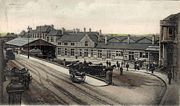
The trains of the South Devon Railway finally reached the town of Plymouth
Plymouth
Plymouth is a city and unitary authority area on the coast of Devon, England, about south-west of London. It is built between the mouths of the rivers Plym to the east and Tamar to the west, where they join Plymouth Sound...
on 2 April 1849. Docks were opened adjacent to the station and a new headquarters office was built next door. The station was expanded ready for the opening of the Cornwall Railway
Cornwall Railway
The Cornwall Railway was a broad gauge railway from Plymouth in Devon to Falmouth in Cornwall, United Kingdom. The section from Plymouth to Truro opened in 1859, the extension to Falmouth in 1863...
on 4 May 1859 and the South Devon and Tavistock Railway
South Devon and Tavistock Railway
The South Devon and Tavistock Railway was a broad gauge railway linking Plymouth with Tavistock in Devon, England. It opened in 1859, was extended by the Launceston and South Devon Railway to Launceston, Cornwall, in 1865, and was closed in 1962....
on 22 June 1859. It became known as "Plymouth Millbay" after other stations were opened in the town in 1876-7 at Mutley and North Road
Plymouth railway station
Plymouth railway station serves the city of Plymouth, Devon, England. It is situated on the northern edge of the city centre close to the North Cross roundabout...
.
The station was closed to passengers on 23 April 1941 after bombs destroyed the nearby goods depot; the passenger station being used thereafter only for goods traffic and access to the carriage sheds. All traffic ceased from 14 December 1969 except for goods trains running through to the docks which continued until 30 June 1971.
The site is now occupied by the Plymouth Pavilions
Plymouth Pavilions
Plymouth Pavilions is an entertainment and sports complex in Plymouth, Devon, England. It has a Fun Pool, Ice Rink, Live Cafe and arena. The arena is used for corporate hire and as an entertainment venue....
leisure complex. Two granite gate posts outside the Millbay Road entrance are all that is left of the station, although a goods shed on what used to be Washington Place is still extant nearby
See also
- Disused railway stations (Bristol to Exeter Line)
- Disused railway stations (Newton Abbot to Kingswear Line)
- Disused railway stations (Plymouth to Penzance Line)Disused railway stations (Plymouth to Penzance Line)There are seventeen disused railway stations between Plymouth in Devon and Penzance in Cornwall, United Kingdom. The remains of nine of these can be seen from passing trains...
- South Devon Railway engine housesSouth Devon Railway engine housesThe South Devon Railway engine houses were built in Devon, England, to power the atmospheric trains on the South Devon Railway between Exeter St Davids and Plymouth Millbay railway stations. They contained boilers that provided the power to pumps that created the vacuum to move the trains...

